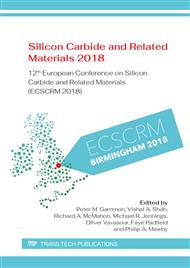p.567
p.572
p.576
p.583
p.588
p.592
p.596
p.600
p.605
Achieving Reduced Specific On-Resistance in 1.2 kV SiC Power MOSFETs at Elevated Temperature
Abstract:
Power MOSFETs operate at elevated temperatures due to self-heating and hot ambient temperatures. This paper analyzes the increase in on-resistance with temperature for 1.2 kV rated 4H-SiC planar MOSFETs. The impact of various structural parameters are studied using analytical models supported by experimental data. This work defines how to achieve a low ratio [Ron(150°C)/Ron(25°C)] by structural optimization of 1.2 kV SiC planar MOSFETs for the first time. It is found that the inversion mode MOSFETs, fabricated by us in a 6 inch commercial foundry, have a lower ratio [Ron(150°C)/Ron(25°C)] than the accumulation mode MOSFETs, due to a better balance of change in channel and bulk mobility with temperature. Compared with typical commercially available MOSFETs, our fabricated accumulation mode and inversion mode MOSFETs exhibit a lower ratio [Ron(150°C)/Ron(25°C)], resulting in superior HF-FOM [RonxQgd] at 150°C.
Info:
Periodical:
Pages:
588-591
Citation:
Online since:
July 2019
Authors:
Price:
Сopyright:
© 2019 Trans Tech Publications Ltd. All Rights Reserved
Share:
Citation:


